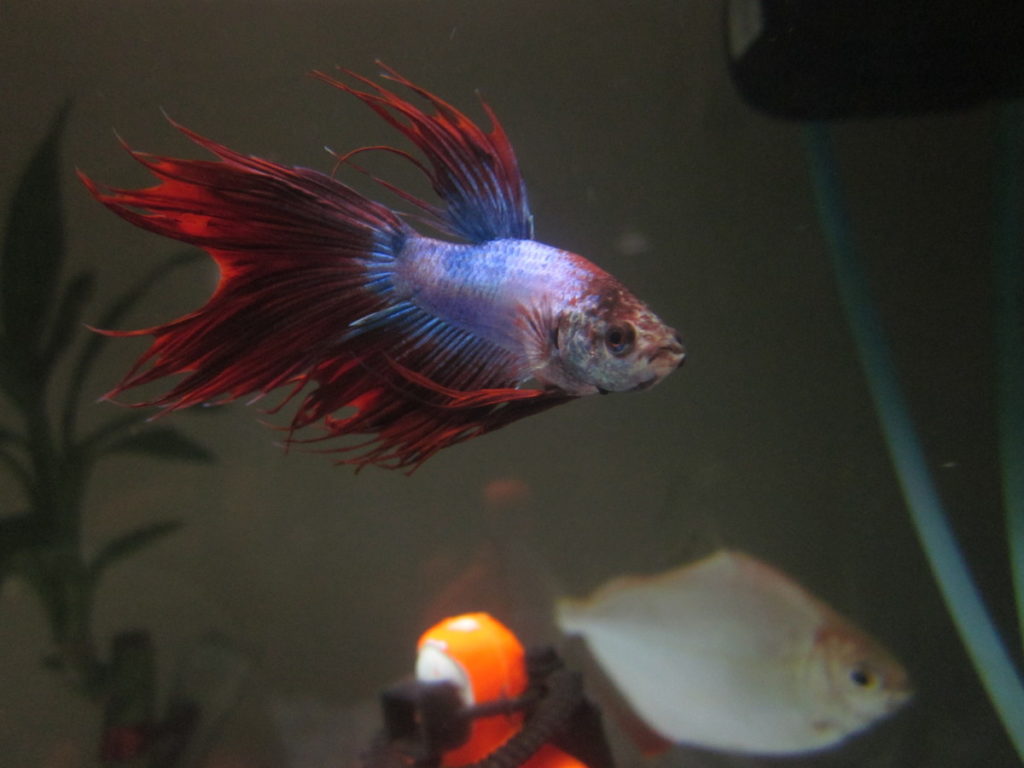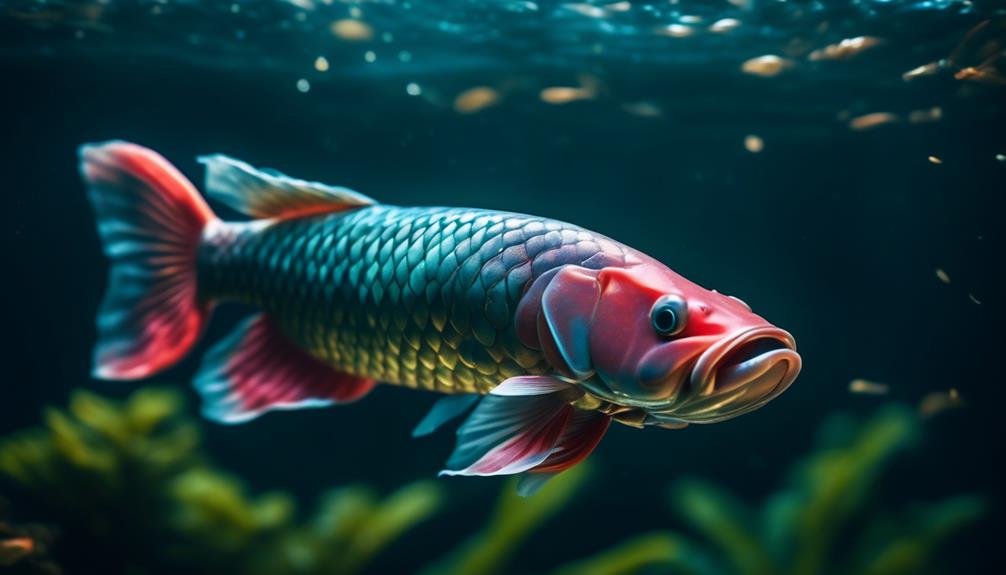
Prepare to be mesmerized by the captivating world of Arowana fish, where fierce beauty reigns supreme. These majestic creatures, with their vibrant colors and commanding presence, are the ultimate challenge for any dedicated aquarium enthusiast. As you dive into the depths of their care and keeping, you’ll uncover the secrets to creating the perfect habitat for these powerful swimmers.
But beware, the journey ahead is not for the faint of heart. With their aggressive temperament and unique dietary needs, the Arowana fish will test your skills and determination like no other.
Are you ready to embark on this thrilling adventure and unlock the mysteries of the Arowana fish?
Key Takeaways
- Arowanas are large, aggressive freshwater fish that require large tanks or outdoor ponds.
- They have vivid and vibrant colors, with Asian Arowanas being the most exotic and colorful species.
- Arowanas are powerful jumpers, so a tightly covered aquarium is necessary.
- Proper feeding and water conditions are crucial for the health and well-being of Arowanas.
Arowana Fish: Size and Temperament
Arowana fish are known for their impressive size and aggressive temperament. These freshwater fish can grow very large, with the Asian Arowana reaching up to 35 inches long. They require a large aquarium, preferably 50 gallons or more, as they need ample space to swim near the surface of the water.
Arowanas originated in South America, Australia, Asia, or Africa, and each species has its own unique characteristics. The Asian Arowana is the most exotic and colorful, with vivid hues of green, blue, gold, silver, and blood red. On the other hand, the Silver Arowana from South America and the Australian Arowanas tend to have more subdued coloring.
Despite their beauty, it’s important to note that Arowanas are aggressive and prefer to be alone in an aquarium.
Types of Arowanas: Exotic Colors and Origins
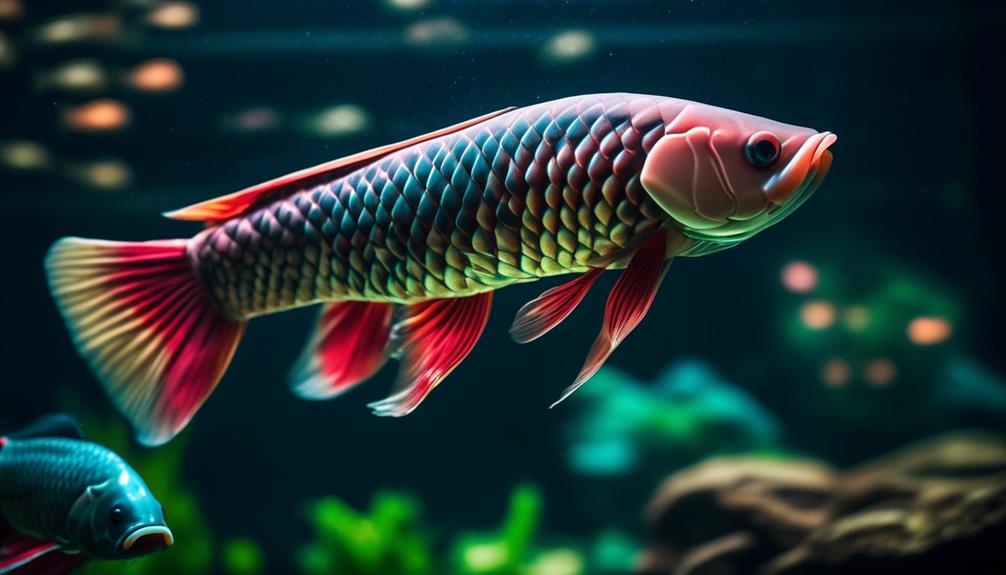
With their sleek, metallic scales and vibrant colors, Arowanas captivate aquarium enthusiasts around the world. These magnificent fish come in various types, each boasting exotic colors and unique origins.
The most coveted species is the Asian Arowana, known for its vivid and vibrant hues like green, blue, gold, silver, and blood red. Originating from South America, the Silver Arowana maintains its stunning color throughout its life. Similarly, the Black Arowana, also native to South America, showcases its striking black shade as it matures.
On the other hand, Australian Arowanas tend to have more muted colors, leaning towards darkish grey and brown tones. Regardless of the type, Arowanas are a true spectacle, adding beauty and allure to any aquarium.
Arowana Habitat: Tank Size and Water Conditions
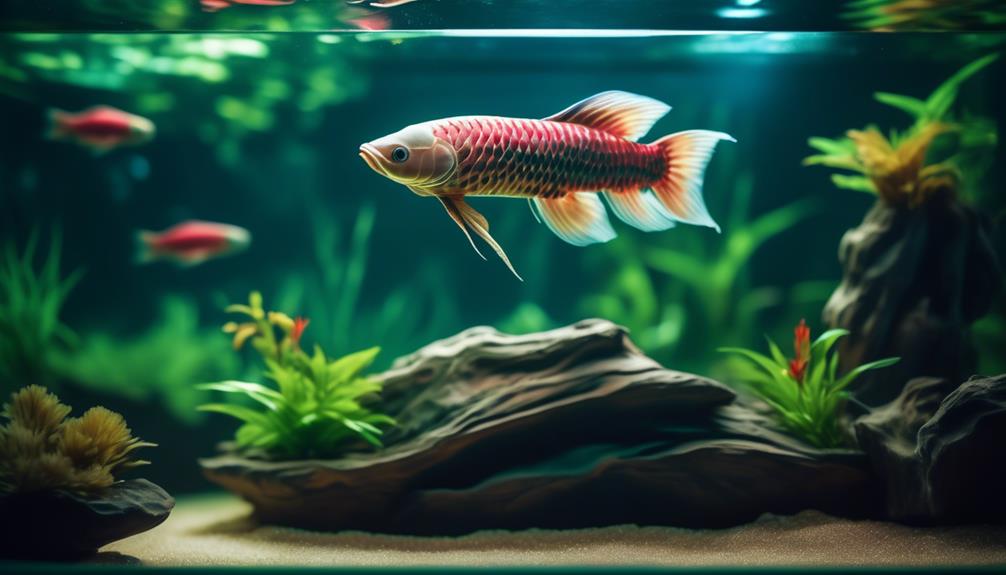
To create an ideal habitat for an Arowana, it’s crucial to consider the appropriate tank size and maintain optimal water conditions.
Arowanas are very large freshwater fish that require spacious tanks to thrive. A minimum tank size of 50 gallons is recommended, but larger tanks of over 250 gallons or outdoor ponds are preferable. These fish swim near the water’s surface, so they need ample space to move freely. Additionally, Arowanas are powerful jumpers, so it’s essential to have a tightly covered aquarium to prevent any escapes.
As for water conditions, Arowanas are sensitive to water quality. Regular water changes of up to 20% twice a week and a strong filtration system are necessary to keep the water clean and well-maintained.
Feeding Arowanas: Carnivorous Diet and Challenges
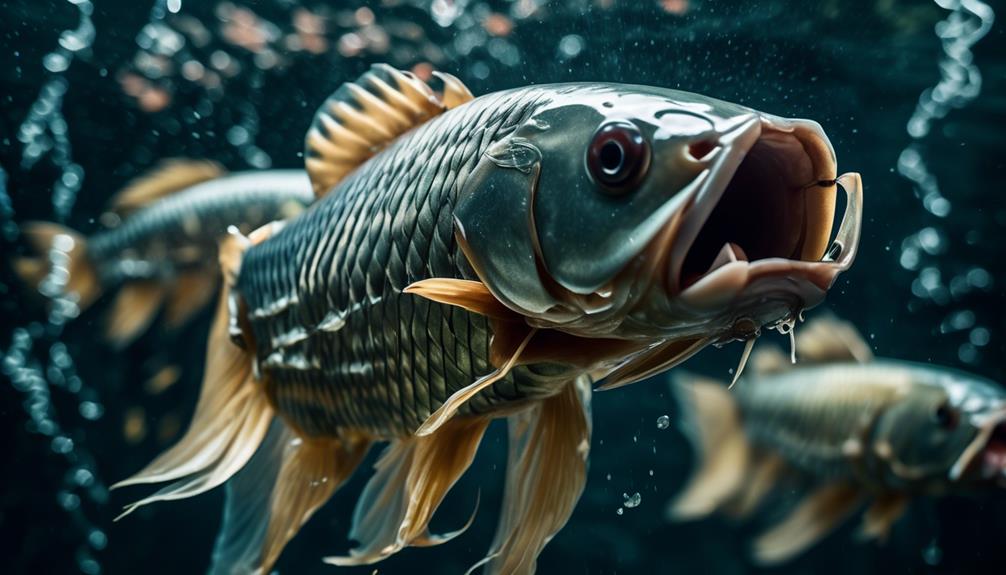
Creating the ideal habitat for your Arowana involves not only providing the appropriate tank size and water conditions but also understanding their carnivorous diet and the challenges it presents. Arowanas are carnivores with strong predatory instincts, and some adults only accept live foods. Feeder goldfish, frogs, and shrimp can be part of their diet. However, feeding can be a challenge due to their preferences. It’s crucial to properly feed them to ensure their health and well-being.
Arowanas are heavy eaters and produce a lot of waste, so careful attention to water conditions is necessary. It’s recommended to perform water changes of up to 20% twice a week and invest in a powerful filtration system.
Arowana Tank Mates: Fish to Avoid in Your Aquarium
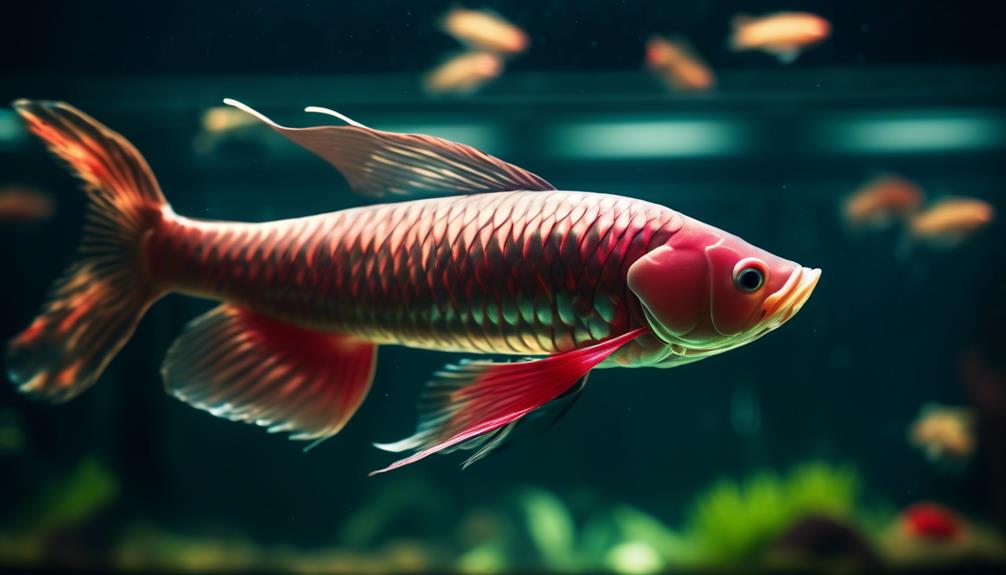
When considering tank mates for your Arowana, it is important to be aware of the fish species that should be avoided in your aquarium. Certain fish can pose a threat to the Arowana or may not be compatible due to differences in size, temperament, or dietary requirements. To help you make informed decisions, here are some fish species that you should avoid keeping with your Arowana:
| Fish to Avoid | Reason for Avoidance |
|---|---|
| Common Pleco | Outgrows most tanks |
| Pacu | Aggressive and can break tank glass |
| Red Tail Catfish | Grows large and eats tank mates |
| Bala Sharks | Need to be kept in groups, may not be compatible |
Common Pleco: Why It’s Not Suitable for Most Tanks
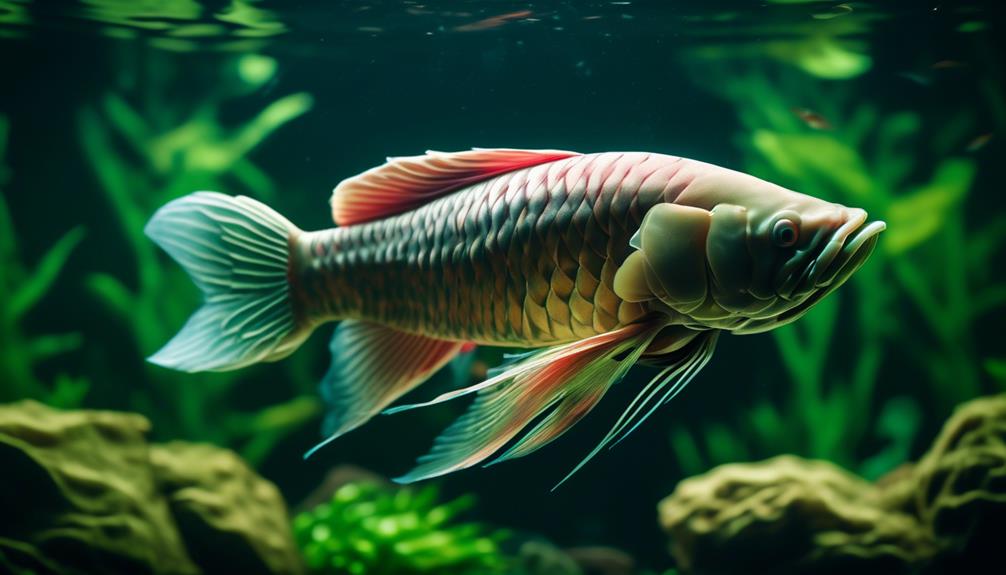
If you’re considering adding tank mates for your Arowana, it’s crucial to understand why the Common Pleco isn’t suitable for most tanks.
Common Plecos can grow too large for average home aquariums, reaching sizes of up to 18 inches and living for 30 years. Taking care of algae yourself is easier than having a Common Pleco, making it a less desirable option.
Instead, it’s recommended to choose a smaller variety like the bristlenose pleco.
Being a responsible pet owner means knowing about your pets before bringing them home.
Arowana Care: Tank Size, Aggression, and Growth
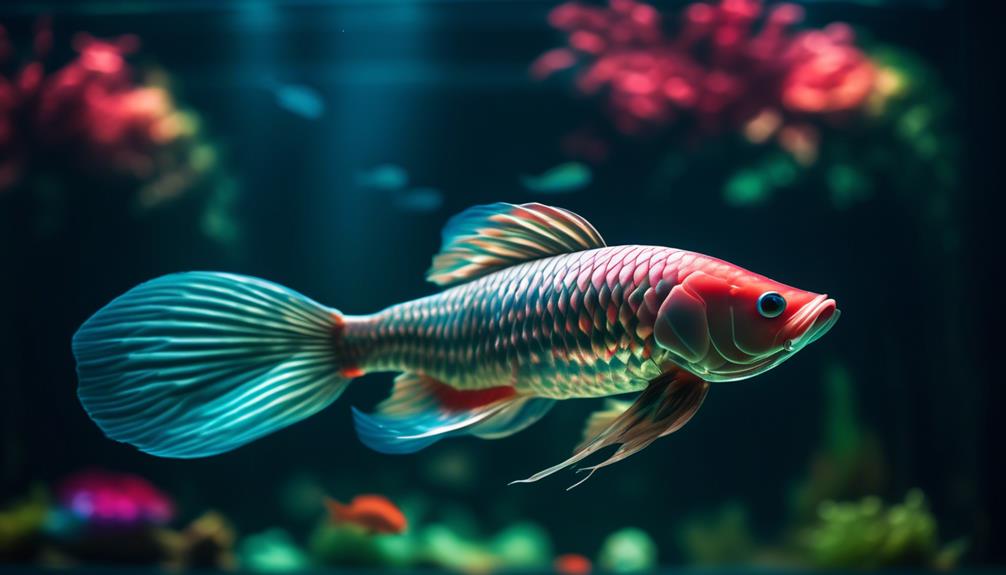
To properly care for your Arowana, there are a few key considerations to keep in mind. Firstly, it’s essential to consider the appropriate tank size. Arowanas are very large fish, so they require a spacious aquarium of at least 50 gallons. This will give them enough room to swim near the surface, as they prefer.
Another important aspect of Arowana care is managing their aggression. Arowanas have an aggressive temperament and prefer to be alone in the aquarium. Keeping them with other fish can lead to disaster. It’s best to provide them with a solitary environment where they can thrive without any conflicts.
Lastly, monitoring their growth is crucial for their overall well-being. Arowanas can quickly reach a length of 35 inches, especially the Silver Arowana species. Therefore, it’s important to keep an eye on their growth and ensure they have enough space to thrive in their environment.
Pacu: Arowana’s Aggressive Relative to Avoid
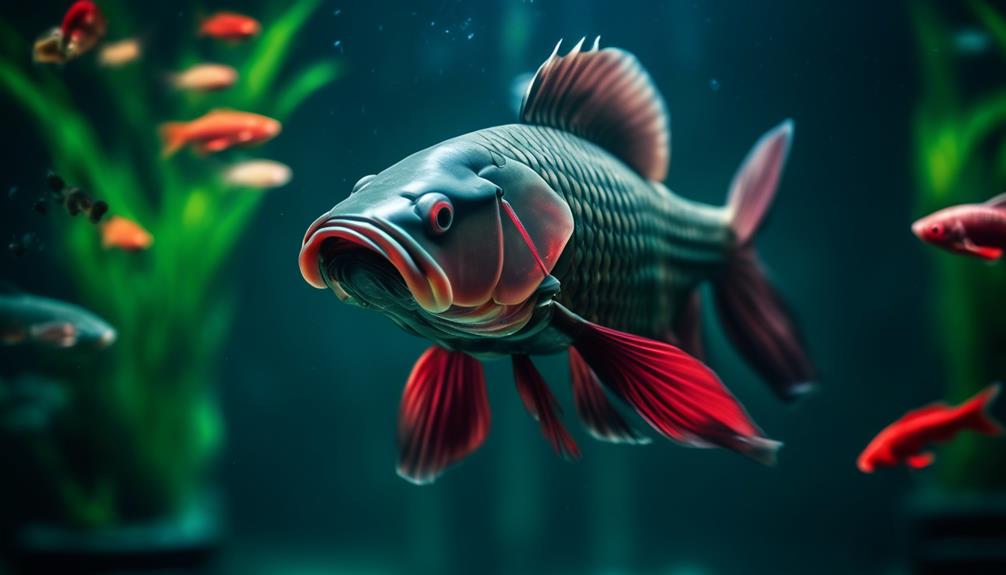
To ensure the well-being of your Arowana and avoid potential disasters, it’s crucial to steer clear of the Pacu, an aggressive relative that should be avoided in your aquarium.
Pacus, related to piranhas, can grow up to 3 feet long and weigh up to 55 lbs. With teeth similar to humans, they can easily break tank glass with a swift hit.
Pacus are omnivorous and will quickly eat tank mates, making them a threat to the peaceful environment you have established for your Arowana.
Instead of introducing Pacus into your aquarium, it’s recommended to consider smaller varieties of cichlids that are more compatible and won’t pose a danger to your Arowana’s well-being.
Frequently Asked Questions
How Often Should I Change the Water in My Arowana Tank and What Size Filtration System Do I Need?
You should change the water in your arowana tank twice a week, doing up to 20% water changes each time. It’s crucial to have a powerful filtration system to handle their waste.
What Are Some Common Challenges When It Comes to Feeding Arowanas and How Can I Overcome Them?
Feeding arowanas can be challenging due to their preferences. Some only accept live foods, like feeder goldfish, frogs, and shrimp. Proper feeding is crucial for their health.
Can Arowanas Be Kept in a Community Tank With Other Fish, or Do They Prefer to Be Alone?
Arowanas prefer to be alone in an aquarium. Keeping them in a community tank can lead to disaster. It’s best to provide them with a spacious tank and a well-equipped environment where they can thrive on their own.
What Are the Ideal Tank Mates for Arowanas and Why Should I Avoid Certain Species?
Avoid keeping tank mates with arowanas as they prefer to be alone. Some species, like the common pleco, grow too large for most aquariums. It’s best to research and choose smaller, compatible fish for your arowana’s tank.
Why Is the Common Pleco Not Suitable for Most Home Aquariums and What Are Some Alternative Options?
The common pleco is not suitable for most home aquariums because it grows too large. It’s easier to take care of algae yourself than to have a common pleco. Consider a smaller variety like bristlenose pleco instead.
Are Harlequin Tuskfish Suitable for Aquariums Like Arowana Fish?
Yes, the harlequin tuskfish is a suitable choice for aquariums like the arowana fish. Known for its vibrant colors and bold patterns, this species can thrive in larger tanks with plenty of hiding spots. As long as their needs are met, they can be a stunning addition to any aquarium.
Conclusion
In conclusion, caring for Arowana fish is a challenging yet rewarding experience.
These fierce and beautiful creatures require a large aquarium with open swimming spaces and hiding spots.
They’re carnivorous and prefer live foods, making feeding a challenge.
Maintaining water conditions can also be demanding due to their heavy eating habits and waste production.
However, with dedication and proper care, Arowanas can thrive and provide a captivating addition to any aquarium.

